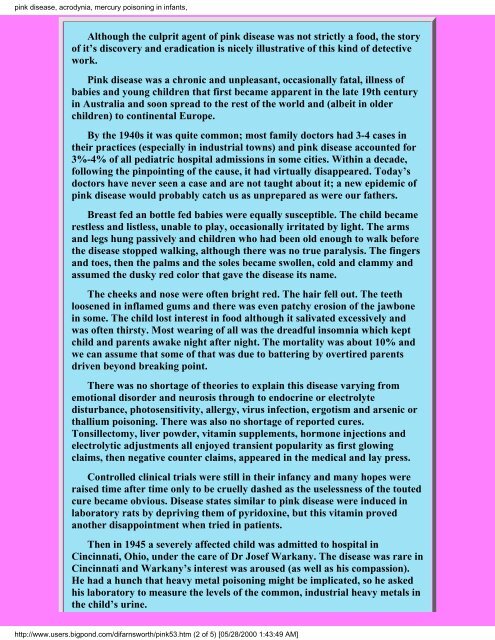Create successful ePaper yourself
Turn your PDF publications into a flip-book with our unique Google optimized e-Paper software.
pink disease, acrodynia, mercury poisoning in infants,Although the culprit agent of pink disease was not strictly a food, the storyof it’s discovery and eradication is nicely illustrative of this kind of detectivework.Pink disease was a chronic and unpleasant, occasionally fatal, illness ofbabies and young children that first became apparent in the late 19th centuryin Australia and soon spread to the rest of the world and (albeit in olderchildren) to continental Europe.By the 1940s it was quite common; most family doctors had 3-4 cases intheir practices (especially in industrial towns) and pink disease accounted for3%-4% of all pediatric hospital admissions in some cities. Within a decade,following the pinpointing of the cause, it had virtually disappeared. Today’sdoctors have never seen a case and are not taught about it; a new epidemic ofpink disease would probably catch us as unprepared as were our fathers.Breast fed an bottle fed babies were equally susceptible. The child becamerestless and listless, unable to play, occasionally irritated by light. The armsand legs hung passively and children who had been old enough to walk beforethe disease stopped walking, although there was no true paralysis. The fingersand toes, then the palms and the soles became swollen, cold and clammy andassumed the dusky red color that gave the disease its name.The cheeks and nose were often bright red. The hair fell out. The teethloosened in inflamed gums and there was even patchy erosion of the jawbonein some. The child lost interest in food although it salivated excessively andwas often thirsty. Most wearing of all was the dreadful insomnia which keptchild and parents awake night after night. The mortality was about 10% andwe can assume that some of that was due to battering by overtired parentsdriven beyond breaking point.There was no shortage of theories to explain this disease varying fromemotional disorder and neurosis through to endocrine or electrolytedisturbance, photosensitivity, allergy, virus infection, ergotism and arsenic orthallium poisoning. There was also no shortage of reported cures.Tonsillectomy, liver powder, vitamin supplements, hormone injections andelectrolytic adjustments all enjoyed transient popularity as first glowingclaims, then negative counter claims, appeared in the medical and lay press.Controlled clinical trials were still in their infancy and many hopes wereraised time after time only to be cruelly dashed as the uselessness of the toutedcure became obvious. <strong>Disease</strong> states similar to pink disease were induced inlaboratory rats by depriving them of pyridoxine, but this vitamin provedanother disappointment when tried in patients.Then in 1945 a severely affected child was admitted to hospital inCincinnati, Ohio, under the care of Dr Josef Warkany. The disease was rare inCincinnati and Warkany’s interest was aroused (as well as his compassion).He had a hunch that heavy metal poisoning might be implicated, so he askedhis laboratory to measure the levels of the common, industrial heavy metals inthe child’s urine.http://www.users.bigpond.com/difarnsworth/pink53.htm (2 of 5) [05/28/2000 1:43:49 AM]


